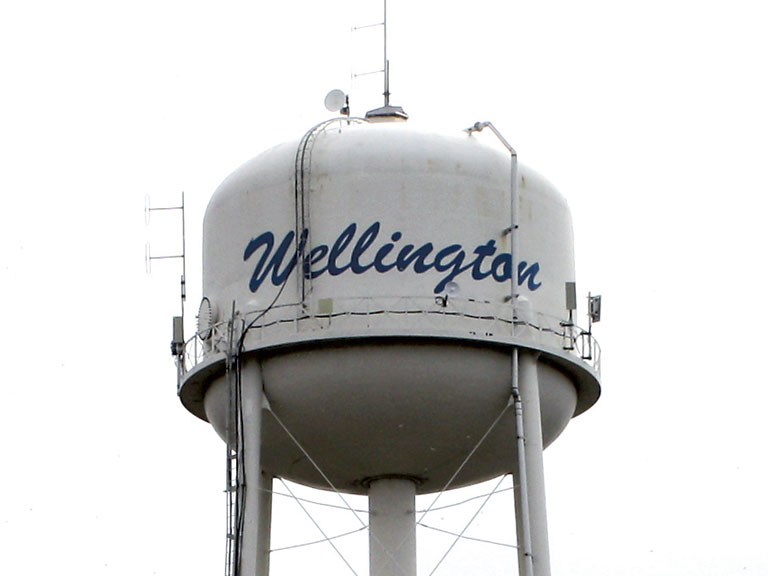County News
Waterworld

Imagining the future of Wellington’s waterworks
Imaginary worlds are expensive. Really, really expensive. For several months now, engineering consultants have been busy imagining Wellington in the future. A future in which the village population is four times larger than it is today. Specifically, they have been tasked to imagine what Wellington waterworks ought to look like in this fantastical future.
How expensive? The price tag is currently about $100 million.
It is such a large number it is difficult to make sense of the exercise. Wellington has bounced between 1,500 and 2,000 souls for more than a century. The current pressure on the population is downward. Yet we are making plans today, for a future with 8,500 villagers.
RVA, an engineering consultancy, unveiled its recommendations for Wellington’s waterworks imagining a build-out to this future population. In fairness, this was their assignment from the central planners at Shire Hall.
They recommend a new water plant ($29.3 million) including a new source pipe, and a new wastewater treatment plant ($26 million). Bear in mind that the village’s current plants and source pipe are in good shape, work well and are significantly underutilized— that is, that each has much more capacity than we currently use.
The engineers explain, however, that tying new and old plants together will increase the overall cost and perhaps diminish reliability (more points of potential failure).
RVA is also recommending replacing the water tower with a new taller structure on Belleville Road south of the arena ($7 million). Water tower construction extra ($6.5 million). They propose a new water main along the Millennium Trail connecting the new water tower to the plant ($9 million). A new sewer line would be installed beside the water main to serve the planned subdivisions north of the Millennium Trail ($16 million).
Finally, there are a series of stormwater management projects recommended around the village (totalling $12.5 million).
It is important to remember that the County has a spotty record estimating waterworks projects. The original estimate to replace the Picton wastewater treatment facility—the most recent big project—was $16 million. That was the estimate upon which the federal and provincial governments contributed their third share of the cost. But when it was built, the cost had escalated to more than $30 million. All of the balance (+$20 million) was borne by County waterworks customers.
RVA was not part of the Picton sewage plant fiasco. But that experience demonstrates the frailty of planning when the challenge is as simple as replacing a single plant. It suggests that any costs attached to a plan as comprehensive and multifaceted as that contemplated for Wellington at such a preliminary stage must be considered a ballpark starting point.
Ultimately the question comes down to who will pay this bill? Certainly not current users. Debt servicing costs alone would add $100 to every water bill. That could be a hard sell in Consecon and Bloomfield.
The consultants suggest the bulk of these costs might be borne by developers to be passed along to new homeowners, for whom this shiny new capacity is intended to accommodate. Yet it is entirely unclear that we will ever see 8,500 people in Wellington.
Nothing in the village’s historic growth record, current trends or demographics even hints at such a steep trajectory as plausible, or even possible.
Yes, there are several subdivisions in the works that imagine as many as 1,200 new homes in the village. Yet most of these plans have been kicking around for more than a decade, with little movement. Even if all of them were to proceed, there is no evidentiary basis to believe the pace of development would happen quickly enough to justify this massive expenditure.
It is more plausible that rising development charges would further disincentivize new homebuilding— pushing builders to more lucrative markets on the north side of the bridges.
Planning is good. Imagining the big picture and the factors that may shape our community is a worthwhile exercise as a generalized statement. But when the cost of the land-of-make-believe is so far from any reasonable assessment of the village’s growth trajectory, it is difficult to understand the value of the exercise.
Wellington’s waterworks are in good shape. Some folks would like to have a bit more pressure from their taps, but otherwise, the plants and pipes are in good order, generally speaking. We have a terrific source pipe reaching a kilometre into the cold and dark Lake Ontario. We have a good working system with some room for growth.
It is hard to see how this new waterworks plan— which current waterworks users are paying for—is anything but a really expensive fantasy.

Comments (0)